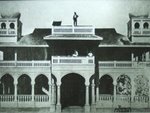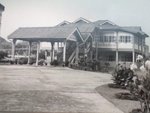Brunei surprisingly, was the last among the Borneo states to have its own postage stamps.
The Dutch East Indies (now Indonesia) which included Kalimantan first issued theirs in 1864, Sarawak in 1869, the British Colony of Labuan, despite not being a state, in 1879 and North Borneo (now Sabah) in 1883.
We, in Brunei, only issued our first postage stamps in 1895 and even those were considered by the early stamp enthusiasts as unofficial.
Prior to that 1895 issue, the first postage stamps used in Brunei were the Sarawak stamps which were used in Muara, then known as Brooketon, as Rajah Brooke ran the coal mining operations there and used those stamps for the postal service in the community from 1893 to 1907.

The first Brunei stamps in 1895 were considered as controversial and known in the stamp world as the 'Brunei Locals'.
Printed in Glasgow by the Manager of the Central Borneo Company of Labuan, a John Robertson who managed to get a monopoly concession from His Majesty Sultan Hashim, (the government gets all internal revenues but he gets all external revenues) was considered as purely speculative.
According to a book about Brunei entitled “On the Fringe of Eastern Seas: The City of Many Waters” written by Peter Blundell, published in 1924, John
Robertson ‘persuaded the Sultan to accept payment for the monopoly with stamps at their face value which he got printed in Germany for a trifling sum.’
The stamps could only be used in Brunei and were unfortunately labeled 'bogus' in its early history.
For Brunei letters to be sent abroad, they had to have additional Labuan stamps as Brunei then was not a member of the Universal Postal Union (UPU).
The Brunei/Robertson’s postal services were also described at best 'spasmodic' during its life but it was the first postal service for the country nevertheless – it ended sometime 1902/3 when John Robertson was transferred to Taritipan in Marudu.
In 1906, the Brunei government started to operate its own postal service.
However the first postage stamps that were due to arrive in Brunei from United Kingdom did not arrive on time and the solution was to overprint the Crown Colony of Labuan postage stamps with the word BRUNEI in Singapore.

The first of these stamps were used in the inauguration of the Post Office located in the Customs House on October 11th, 1906 (some historians argued that it was on October 15th).
In the beginning, the stamps were scarce as collectors and dealers were heavily speculating on the value of the stamps by buying up quantities of the mint stamps for investment.

By 1907, the first official Brunei stamps had arrived known as the Brunei River Type as the stamps depicted a typical Brunei river scene.
A London company, Messrs De La Rue & Co Ltd printed the 1907 stamps and interestingly enough this same company carried on printing other Brunei stamps until about the 1970s.
Between 1908 and 1920, the stamps colours conformed to the UPU requirements of three standard colours - one for printed matter, another for postcard and the third for single letters.
In those days, unlike today's multicoloured and multi-image stamps, the colours were standardised to help assist international recognition of the three classes of mail.
Uniformity of colours was also carried out under the colonial colour scheme so the colours also conformed to their counterparts under the Straits Settlement.
However for today’s stamp collector, it can be quite confusing as there was a proliferation of colours with a number of the stamps undergoing changes in colour – for instance, the 1 cent stamp originally appeared in black and green in the 1907 issue but in subsequent years, in other colours such as all black and all brown.
Postal services in Brunei’s other major towns began son after 1906 with the Tutong Post Office opening in 1908, Bangar in 1909, Belait in 1910, Seria in 1933 and Labi not until 1956.
During the First World War, for the third time in its history, (the others being the Sarawak stamps in Brooketon and the Labuan overprints) Brunei used a different country’s stamps – the Sarawak stamps were used in Brunei as the stock of stamps in Brunei ran out.

In March 1924, a new design was introduced as well as a change in size.
The new stamps showed a panoramic view of Kampong Ayer with Brunei Town in the background.
The designs were adapted from a sketch made by Mr. LA Allan, a former British Resident who in turn took it from a photograph taken by the Mr. Pretty, another former British Resident with the view from Bubungan Dua Belas, then used as the official residence of the British Resident.
When the Japanese occupied Brunei during the Second World War, the Japanese government found and used unused Brunei stamps in 1942 and overprinted them with the words Imperial Japanese Government in Kanji characters.
These stamps were originally sent to Brunei in 'changed colours' and were deliberately unused until the existing stocks had run out.
During the British Military Administration after the end of the Second World War, the three Borneo states used the stamps of Sarawak and North Borneo overprinted "B.M.A." until 1947.
The first commemorative stamps were those that were used to commemorate Sultan Ahmad Tajuddin's Silver Jubilee on 22nd September 1949 (it was supposed to be released on 20th September 1949 but delayed due to public holidays).
The design was similar to the 1924 stamps but with the portrait of His Majesty Sultan Ahmad Tajuddin, the 27th Sultan of Brunei, marking the first time a ruling monarch of Brunei appearing on the stamps of Brunei.
Another release in 1949 was to commemorate that of the 75th Anniversary of the Universal Postal Union.
It wasn't until 1952 before the government issued the first Brunei stamps with the portrait of His Majesty Sultan Haji Omar Ali Saiffudien, the 28th Sultan, thus beginning the modern era of Brunei postage stamps.












No comments:
Post a Comment